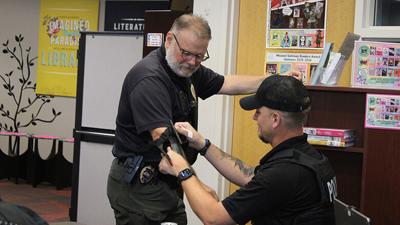This is the second installment in a series about the Jefferson County Sheriff’s Office and the nine major police departments in the area. This week’s installment provides an overview of the training local officers must receive, as well as a story about the training those law enforcement agencies complete in active school threats and a story with an update on the plans to build a regional law enforcement training facility that officers from four counties will use, including those from Jefferson County and Eureka.
Click here to view other stories in this series.
To become a licensed police officer in Missouri, candidates must complete 600 hours of basic training, as mandated by the Peace Officer Standardized Training Program, and pass an exam. Every year, a Missouri officer must continue his or her education with a minimum of 24 hours of training in a variety of subjects, such as legal studies, implicit bias and de-escalation.
Many Jefferson County officers must go above and beyond those minimum training requirements, though.
For example, new officers in the Jefferson County Sheriff’s Office must complete three months of field training with an officer when they’re hired. The Sheriff’s Office also offers officers additional certifications in crime scene analysis, DNA, computer forensics and drug chemistry.
The Hillsboro Police Department requires officers to take additional, annual refresher courses in intermediate weapons, such as batons, pepper spray and tasers.
To be considered for a command staff position, many police departments, like the Arnold, Byrnes Mill and Herculaneum police departments, require officers to undergo leadership training.
Police departments in De Soto, Festus and Eureka strongly prefer command staff hopefuls to obtain associate or bachelor’s degrees.
For this series, the Leader sent out surveys to the Sheriff’s Office and police departments, and over the next few weeks will share that information with readers, as well as information from follow-up interviews.
The following is an overview of information from the surveys about minimum training requirements for the area law enforcement agencies.
Arnold Police Department
- Employees: 69, including 57 officers, eight full-time employees, four part-time employees
- Minimum new officer training requirements: Complete 600 hours basic law enforcement training at a Police Academy; pass Missouri Peace Officer License Exam
- Minimum command staff training: Complete 24 additional hours of continuing law enforcement education (CLEE) annually; complete leadership training
- Minimum officer continuous training: Complete 24 hours of continuing law enforcement education annually; complete state training requirement of two hours interpersonal perspectives, two hours in legal studies, two hours in technical studies, two hours in firearms skill development and 16 hours in electives, which must include one hour on racial profiling, one hour in implicit bias and one hour in de-escalation
Byrnes Mill Police Department
- Employees: 10 full-time officers
- Minimum new officer training requirements: Complete 1,000 hours from an accredited Peace Officer Standards and Training police academy prior to being hired
- Minimum command staff training: Specialized leadership/management/command training
- Minimum officer continuous training: Complete 24 hours of Missouri POST training annually. Officers also complete several hours of online training through MIRMA, the city’s insurance carrier
Crystal City Police Department
- Employees: 22, including 19 officers, two communications specialists, one administrative assistant
- Minimum new officer training requirements: Must have Missouri Peace Officer License
- Minimum command staff training: Officers at all ranks are continually training
- Minimum officer continuous training: Officers receive many hours of training both while in the academy and after employment. This is just part of the job to stay in compliance, to stay current on legal updates and on law enforcement techniques
De Soto Police Department
- Employees: 15 police officers, 6 communication officers and 1 clerical
- Minimum new officer training requirements: Class A peace officer license; MIRMA requires additional training
- Minimum command staff training: Corporal: associate degree preferred; sergeant, associate degree required, bachelor’s degree preferred; captain: bachelor’s degree required
- Minimum officer continuous training: Annual certifications required by Missouri P.O.S.T. Commission must be completed along with firearms training
Eureka Police Department
- Employees: 29 officers, four civilian staff members
- Minimum new officer training requirements: Class A certification with Missouri POST Commission. Sergeants required to have bachelor’s degree or be working on one to be promoted to the position
- Minimum command staff training: Minimum of a bachelor’s degree, graduate of the Missouri Police Chiefs Command College
- Minimum officer continuous training: Maintain class A Missouri POST license; conduct required training specified by insurance provider; officers required to complete eight hours of squad-level training bi-monthly. On average, officers complete more than 100 hours of training annually in a variety of disciplines
Festus Police Department
- Employees: 32 police officers, eight dispatchers and three clerical staff
- Minimum new officer training requirements: High school diploma or GED and Class A Peace Officer Standards and Training certificate
- Minimum command staff training: Sergeants must have at least an associate degree, and captain and chief must have at least a bachelor’s degree
- Minimum officer continuous training: Officers must have at least 24 continuing education hours a year, including two hours of firearms training, one hour of racial profiling, one hour of de-escalation training, and one hour of implicit bias training. Yearly certifications in taser, less lethal, defensive tactics and active shooter, along with several in-house training sessions
Herculaneum Police Department
- Employees: 15, including 12 officers, one clerical staff member and two part-time employees
- Minimum new officer training requirements: Class A license from POST
- Minimum command staff training: Command staff will hold numerous certifications and leadership classes in multiple categories as well as supervisory experience
- Minimum officer continuous training: Each year, every officer has to complete a minimum of 24 CEUs. Of these 24 hours, officers must obtain a minimum of: two hours in legal studies; two hours in technical studies; two hours in interpersonal perspectives; two hours of skill development in the area of firearms; 16 hours of electives (any of the above-listed core curricula areas); one hour of racial profiling training; one hour of implicit bias training; and one hour of de-escalation training
Hillsboro Police Department
- Employees: 12 full-time officers (including command staff); two clerical staff members; various reserve officers
- Minimum new officer training requirements: All officers must meet the state requirements set by the Peace Officer Standards and Training commission; most officers have also completed CIT (Crisis Intervention Team) training; school resource officers have completed appropriate SRO school; others are trained in weapons/defensive tactics, investigations/crime scene processing and traffic enforcement/safety
- Minimum command staff training: No specific additional training required for command staff
- Minimum officer continuous training: Officers must complete state requirements for continuing education by the POST commission; officers also complete refresher courses in intermediate weapons such as batons, pepper spray, tasers, firearms training and more annually; leadership and team development opportunities are offered as well
Jefferson County Sheriff’s Office
- Employees: 252, including 175 deputies and 77 civilian positions
- Minimum new officer training requirements: Complete 600 hours basic law enforcement training at a Police Academy; pass Missouri Peace Officer License Exam; three months of field training with a training officer
- Minimum command staff training: Maintain accreditation and proficiency in area of expertise
- Minimum officer continuous training: Complete 24 hours of continuing law enforcement education annually; complete state training requirement of two hours legal studies, two hours technical studies, two hours interpersonal perspectives, two hours firearms skill development, one hour on racial profiling and 16 hours electives in any of the core areas; additional certifications for SWAT, crime scene, latent print, DNA, computer forensics, DWI and drug chemistry
Pevely Police Department
- Employees: 11 officers; two clerical workers, one animal control officer and six in dispatch
- Minimum new officer training requirements: Didn’t provide information
- Minimum command staff training: Didn’t provide information
- Minimum officer continuous training: Didn’t provide information

Retired Jefferson County Sheriff’s Office Cpl. Charles Wymore volunteered to act as an active shooter during training drills at Herculaneum High School, carrying an Airsoft pellet gun.
Local law enforcement agencies train for school threats
By Abby Stetina and Goldie Lowe
Local law enforcement agencies regularly train for potential threats to the area’s classrooms.
Deputies with the Jefferson County Sheriff’s Office, the county’s largest law enforcement agency, train for active threats twice a year, said Sheriff Dave Marshak. Over the years, deputies have trained at the Festus R-6, Fox C-6, Northwest R-1, Windsor C-1 and Rockwood school districts, he added.
“Our training continues to evolve as we learn from incidents across the country,” Marshak said. “Each event provides valuable lessons that helps us refine our tactics and response strategies. While the primary focus is to neutralize the threat as quickly as possible to save lives, our training also emphasizes the importance of what happens afterward. This includes proper investigation procedures; coordination with the involved agency or institution; effective communication with the community; and support for victims and responders.
“Our goal is to ensure we are fully prepared for every phase of a critical incident.”
Marshak said special operations deputies and SWAT teams conduct the training. Those deputies not only train other Sheriff’s Office deputies, but also assist other agencies that request instruction.
The Sheriff’s Office also has seven full-time and several part-time school resource officers assigned to schools in the Fox, Northwest, Windsor, De Soto, Grandview R-2 and Jefferson R-7 districts, with several certified to train school staff for campus threats.
“Together, these efforts ensure our employees are well-prepared, and our community and schools remain safe and secure,” Marshak said.
The Arnold Police Department is the second largest agency in the county based on square miles covered, size of budget and number of officers. Chief Brian Carroll said each Arnold Police officer is briefed with a map of every school within the city limits, including Fox High, Fox Middle, Fox Elementary, Sherwood Elementary and Rockport Elementary in the Fox district, as well as Holy Family Catholic School and St. John’s Lutheran School.
Before the current school year began, Caroll said three Arnold school resource officers took part in an eight-hour training course focused on active shooter threats. Additionally, Arnold Police completed active shooter scenario training with officials from the Fox district, Rock Community Fire Protection District, Rock Township Ambulance District, Jefferson County 911 Dispatch, Jefferson County Emergency Management Office and the First Baptist Church of Arnold.
“Over 60 educators volunteered, participating along with Arnold Police,” Carroll said. “The training covered threat response, first aid for victims, casualty collection and ensuring EMS and fire access. Command staff formed a unified command, and the Fox district practiced rallying non-injured volunteers, transporting them to reunification points and reuniting them with their families.”
Officer Joshua Lambrich, the Arnold Police Department’s public relations training officer, is in charge of getting Arnold Police officers trained on the response to school threats, the elimination of the threat and post-shooting techniques, Carroll said.
“Officer Lambrich is continually updating and refining tactical responses to active shooter events, drawing on lessons from recent incidents,” Carroll said. “It is crucial to adopt successful techniques from other departments and to learn from their mistakes to avoid repeating them. This process ensures that the Arnold Police Department remains prepared and effective in handling such critical situations.”
First-hand account of active threat training
Over the summer, Herculaneum Police Chief Sharia Kyle invited Leader reporters Abby Stetina and Goldie Lowe to observe the department’s active killer training at Herculaneum High School.
“When she invited us, I wasn’t sure what to expect,” Lowe said. “I’m old enough that active shooter training was never a part of my life when I was in school. Several school shootings had happened by the time I was in high school, but it was not a regular enough occurrence that we trained for that scenario.
“As an adult, I have gone through a couple of work-related active shooter trainings, but most of those have been five-minute videos you watch once every couple of years. I was curious to see what in-person training looked like, especially from the perspective of first responders, rather than as a potential victim.”
Lowe said Chief Kyle talked about the importance of the public not knowing too many details about the police active-shooter training and asked the Leader to use discretion about what was shared in this story. She said the less the public knows about how the police are trained to respond, the more tactical advantage the police will have over perpetrators.
Kyle said police like to conduct training in schools and other buildings to help them prepare for real-life scenarios. All Herculaneum Police Department officers participated in the two-day training, with half attending one day and the rest on the second day. The training took place during summer break, when school was out of session.
The department currently has 12 full-time officers, including one officer deployed in Jordan, and two part-time officers. The training is part of their preparedness and response protocols.
First aid training
To begin the training day, Kenny Strathmann, chief operations officer for the Joachim-Plattin Ambulance District, led a class on medical equipment training for officers.
He showed officers different techniques for tourniquet application, emphasizing the “high and tight” method. Trainees used combat application tourniquets, which are one-handed tourniquets.
Those tourniquets should be applied 2 to 4 inches above the wound and tightened using a windlass, Strathmann said.
Strathmann walked officers through alternate ways to apply tourniquets on children and other patients who are too small for normal equipment. The officers also were trained on using gauze for packing gunshot wounds.
Active threat/active killer
After that, Capt. Mark Grobe led a discussion about the changing language around active threat situations, explaining that an “active threat” is when a suspect is actively engaged in causing or threatening to cause death or grave bodily injury to a large number of potential victims, and the threat is ongoing when law enforcement arrives.
He said police now tend to refer to those scenarios as “active killer” situations, rather than “active shooter.”
“I think it’s just getting the mindset out of everybody thinking automatically active shooter all the time, as it’s an active killer situation because there have been so many different ways of killing, like stabbing, cars and bombs,” Grobe said.
Post-Uvalde threat response
Kyle said response training changes were made after the 2022 shooting at Robb Elementary School in Uvalde, Texas. Law enforcement officials in Uvalde were criticized for waiting a long time before officers breached the classroom where the active shooter had barricaded himself. Before breaching the classroom, officers had violent conflicts with parents attempting to enter the school to rescue their children.
Kyle said the conventional response was to make a perimeter and wait for SWAT to arrive. The new response involves local officers entering the building immediately, sometimes alone, until backup arrives.
School Resource Officer Brad Tavener gave officers a tour of the high school campus to ensure all were familiar with the layout.
Herculaneum officers used airsoft guns to confront trainer Chuck Wymore, who is an instructor at the Jefferson College Law Enforcement Academy after retiring from the Sheriff’s Office.
Officers were guided through several scenarios in different areas of the school so they would have experience responding to active shooters in long, narrow hallways; in small, enclosed areas, such as classrooms or offices; and large open areas like cafeterias, theaters and gyms.
Officers trained how to respond to active killer situations when there are different numbers of officers available to respond. With a small police force like the Herculaneum Police Department, sometimes only a few officers will be available at any given time.
“We chose to focus on what’s more likely that we’re going to encounter, if there’s going to be one of us, maybe two, maybe three, probably not more than that, when something would happen. So that’s why we’re doing this single response training,” said Herculaneum Police Cpl. Larry Miller.
“Realistically, we’re not going to have a four- or five-man team coming in here and clear this building,” Grobe said. “If there’s an active shooter in a building, I’m going in if I’m by myself, because the way I look at it, I have a 50-50 chance of walking out of a gunfight alive. These teachers and students have zero.”
Objectives for the training scenarios were reducing casualties and neutralizing the active killer, whether through capture, incapacitation or death. The training highlighted the importance of quick contact with the active killer.

An artist’s rendering of the Gateway Law Enforcement Training Center. Designs for the facility are not finalized.
Regional law enforcement training facility committee meets
By Tony Krausz
Progress is being made to build a regional law enforcement training facility that will serve four counties, Jefferson County Sheriff Dave Marshak said.
Jefferson, St. Louis, St. Charles and Franklin counties entered a partnership this summer to build the Gateway Regional Law Enforcement Training Center.
As part of the agreement, a commission was formed to oversee a $50 million Missouri Department of Public Safety grant approved by the Missouri state Legislature to fund the construction of the training center. The commission has four members representing St. Louis County, two representing St. Charles County, one representing Jefferson County and one representing Franklin County.
Marshak, the Jefferson County commission member, said the group met for the first time on Oct. 16.
“We approved the bylaws and established a subcommittee to work on things like site selection,” he said. “We agreed to establish a website where meeting minutes and progress can be posted for the community and established a meeting schedule for the commissioners. The first meeting was productive, but there is a long way to go.”
St. Louis County Executive Sam Page appointed the four commission members for that county – attorneys Dudley McCarter of Behr, McCarter, Neely & Gabris and Michelle Schwerin of Neill Schwerin Boxerman; Roland J. Corvington, a former FBI special agent in charge of the St. Louis Field Division; and May Scheve Reardon, vice president of government relations at Pollard Banknote.
St. Charles County Executive Steve Ehlmann appointed St. Charles County Police Chief Kurt Frisz and St. Charles County assistant director of administration Bryan Ludwig to the commission.
Jefferson County Executive Dennis Gannon appointed Marshak, and Franklin County Presiding Commissioner Dave Schatz appointed Franklin County Sheriff Steve Pelton.
“When you are working through different boards and governmental agreements, the process is complex,” Marshak said. “We are working through all of the issues. Everyone comes to the table with their own experiences, and several are attorneys, who have their own experiences with agreements, contracts and bylaws. There are a lot of discussions that happen to make sure everyone is on the same page. So far, everything is going smoothly.”
Preliminary plans called for the proposed facility to be built near the intersection of I-64 and Hwy. 141 in St. Louis County, which was considered the demographic center for the participating agencies. However, Marshak said the commission will consider other locations as well.
“(The subcommittee) will bring several site selections back to the commission to weigh in on,” he said.
Marshak also said the commission members were shown a website that is expected to be up and running soon.
“It is necessary for us to be transparent and talk about our progress,” he said.
The $50 million grant does not cover unforeseen construction costs or ongoing maintenance costs for the facility, meaning the commission will need to find a way to provide future funding for the training center.
Marshak previously said Jefferson County’s share to maintain the facility and cover training costs would be an estimated $20,000 to $30,000 annually, covered by the Sheriff’s Office training budget and grants, adding that it is important for the counties to invest in the training center.
He previously said the facility would provide critical training scenarios, mimicking real-life events law enforcement officers face. It is expected to include a shooting range, secured driving track and two basketball courts, among other features.
The facility would be used by more than 5,000 officers across the four participating counties for basic training and annual, ongoing training. The facility would include simulation rooms, tactical operations training spaces and public-viewing catwalks over certain training rooms.
“You want better police,” Marshak said. “They require more training.”









